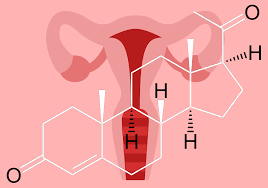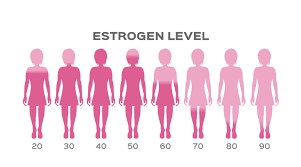endometriosis refers to the inflammatory reaction caused by the presence of active, estrogen-sensitive endometrioid glands and stroma outside the endometrium. The disease is most common in women of childbearing age, with an incidence of 6-10%, ranging in age from 12 to 80. Pain is the main symptom of endometriosis, which can be manifested as dysmenorrhea, sexual intercourse pain or pelvic pain.
Progesterone is a kind of steroid hormones, which mainly come from an ovary, adrenal gland, and placenta. During the periods, estrogen promotes endometrial proliferation. After ovulation, the luteal body secretes progesterone, which makes the endometrium enter the secretory phase until the embryo implantation or menstruation. Progesterone is a synthetic progesterone-like drug, which has different effects on the hypothalamus-pituitary axis and metabolism due to its different components.

Recent studies have shown that increased cyclooxygenase and aromatase activity leads to increased chronic inflammatory response, macrophages and inflammatory factors. Abnormal immune function results in the removal of reflux endometrial tissue and promotes the adhesion and invasion of active endometrial cells.
Pregnendione is a synthetic drug similar to progesterone. Fifty years of clinical practice has shown that oral progesterone is effective in the treatment of endometriosis. It is reported that 90% of the patients had pain relief or disappearance after progesterone treatment. But the problem we face is a relapse after withdrawal.
Regardless of the different treatments, it is long-term, repeated drug use. In the course of treatment, clinicians should evaluate not only the effectiveness but also drug tolerance and treatment cost. Therefore, first-line drugs should be used for a long time with minimal side effects.
Recently, Professor Altay of Istanbul University in Turkey summarized the application of progesterone in endometriosis. The results showed that progesterone is effective in the treatment of endometriosis. The first-line drugs are oral contraceptives and progesterone, and the effectiveness of the drug cycle, dosage and combination are concerned. Further discussion is needed, the article was published in Women's Health.
Progesterone preparations include oral drugs, injections, subcutaneous implants, and intrauterine devices. Non-steroidal anti-inflammatory drugs can be used to alleviate pain caused by endometriosis. Hormone inhibition therapy can be given to those who fail to treat endometriosis.

The main principle of treatment is to cause amenorrhea. The first-line treatment was oral contraceptives and oral progesterone which is followed by gonadotropin-releasing hormone analogues. Danazole has also been shown to be effective in pain control. The intrauterine device containing levonorgestrel can be used for dysmenorrhea caused by endometriosis. Aromatase inhibitors such as letrozole and anastrozole are also effective.
The specific mechanism of progesterone in relieving pain in endometriosis is not yet clear, because the causes of pain caused by endometriosis are not yet clear. The following are possible reasons:
1. Exfoliation and bleeding of active intimal tissue in ectopic tissue.
2. Overexpression of growth factors and stimulation of inflammatory factors in lesions.
3. Pathological changes infiltrate the pelvic nerve and cause pain stimulation.
Progesterone can promote ectopic endometrial tissue atrophy, promote ovulation, inhibit vascular growth and has an anti-inflammatory effect. The role of progesterone is to promote endometrial secretory phase changes, but different derivatives require different doses.
Long-term use of progesterone can lead to ovarian ovulation dysfunction and decrease serum steroid hormones. Long-term low estrogen status and high progesterone lead to endometrial changes in the secretory phase. Breakthrough bleeding often occurs due to low estradiol.

Treatment effect
A retrospective observational study
For the progesterone dosage of 5-20 mg/d, the pain relief rate was 60%-94%. When irregular vaginal bleeding occurs, the dosage of progesterone, estrogen supplementation can be increased or progesterone can be stopped for 5-7 days.
A prospective randomized controlled study
Vercellini et al. studied the effect of 0.02 mg ethinylestradiol combined with 0.15 mg deoxypregnene and 3.6 mg noride on pain relief. After one year, both of them had significant pain relief effect, but there was no statistical difference.
Deep endometriosis
The surgical excision of the lesion is recommended. A study of CPA shows that after pain relief of deep endometriosis by Mirena can be as effective as a 6-month use of progesterone.
In summary, the efficacy of progesterone in the treatment of endometriosis is affirmative. Although the types of drugs include oral drugs, injectable drugs, and intrauterine device systems, all kinds of preparations have the same efficacy in relieving pain, but there is no absolute advantage. The first-line drugs are oral contraceptives and progesterone. The period, dosage and the effectiveness of the combined use of drugs need to be further explored.

If patients are still worried about the side effects of progesterone, they can also choose Fuyan Pill, a safe and reassuring natural medicine. Formula contains Bupleurum chinense, Poria cocos, Chinese yam, peach kernel, angelica, honeysuckle, corydalis tuber and other natural herbs which not only make the Fuyan pill has a strong bactericidal effect, but also make it has the effect of promoting blood circulation and removing blood stasis, promoting Qi and relieving pain and invigorating the spleen and dampness, reduce the discomforts of the patients thoroughly.

